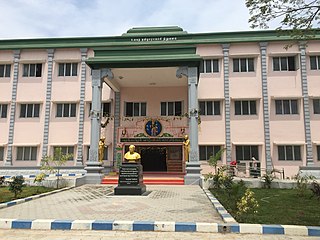 W
WTamil is a Dravidian language natively spoken by the Tamil people of South Asia. Tamil is an official language of the sovereign nations of Sri Lanka and Singapore, the Indian state of Tamil Nadu, and the Union Territory of Puducherry. Tamil is spoken by significant minorities in the four other South Indian states of Kerala, Karnataka, Andhra Pradesh and Telangana and the Union Territory of the Andaman and Nicobar Islands. It is also spoken by the Tamil diaspora found in many countries, including Malaysia, Myanmar, South Africa, United Kingdom, United States, Canada, Australia and Mauritius. Tamil is also natively spoken by Sri Lankan Moors.
 W
WThe history of Bible translations into the Tamil language commences with the arrival of Bartholomäus Ziegenbalg at Tranquebar in 1706.Johann Philipp Fabricius, a German, revised Ziegenbalg's and others work to produce the standard Tamil version. Seventy years after Fabricius, at the invitation of Peter Percival a Saiva scholar, Arumuka Navalar, produced a "tentative" translation, which is known as the "Navalar version," and was largely rejected by Tamil Protestants.
 W
WThe Central Institute of Classical Tamil (CICT) is a body established by the Government of India with a view to promoting the cause of Classical Tamil. It is located in Chennai.
 W
WThe Grantha script is a South Indian script, found particularly in Tamil Nadu and Kerala. Originating from the Pallava script, the Grantha script is related to the Tamil and the Vatteluttu scripts. The modern Malayalam script of Kerala is a direct descendant of the Grantha script. The Southeast Asian and Indonesian scripts such as Thai and Javanese respectively, as well as South Asian Tigalari and Sinhala scripts are derived or closely related to the Grantha through the early Pallava script. The Pallava script or Pallava Grantha, emerged in the 4th century CE and was used until the 7th century CE, in India. This early Grantha script was used to write Sanskrit texts, inscriptions on copper plates and stones of Hindu temples and monasteries. It was also used for classical Manipravalam – a language that is a blend of Sanskrit and Tamil. From it evolved Middle Grantha by the 7th century, and Transitional Grantha by about the 8th century, which remained in use until about the 14th century. Modern Grantha has been in use since the 14th century and into the modern era, to write classical texts in Sanskrit and Dravidian languages. It is also used to chant hymns and in traditional Vedic schools.
 W
WThe International Institute of Tamil Studies (IITS) is a linguistic research institution based in Chennai, India. It was established with a view to promoting the cause of Tamil language.
 W
WThe Āathichoodi is a collection of single-line quotations written by Avvaiyar and organized in alphabetical order. There are 109 of these sacred lines which include insightful quotes expressed in simple words. It aims to inculcate good habits, discipline and doing good deeds.
 W
WVinayagar Agaval is a devotional poetic hymn to the Hindu deity Ganesh. It was written in the 10th century during the Chola dynasty by the Tamil poet Avaiyar, shortly before her death. It is considered to be her greatest poem. The 72-line 'Agaval' is a form of blank verse, close to speech.
 W
WThe development of Old Tamil into Middle Tamil, which is generally taken to have been completed by the 8th century, was characterised by a number of phonological and grammatical changes despite maintaining grammatical and structural continuity with the previous form of the language. In phonological terms, the most important shifts were the virtual disappearance of the aytam (ஃ), an old phoneme, the coalescence of the alveolar and dental nasals, and the transformation of the alveolar plosive into a rhotic.
 W
WThis article is about the number words of the Tamil language, as well as the dedicated symbols for them used in the Tamil script.
 W
WOld Tamil is the period of the Tamil language spanning the 450 BCE to the 7th CE. Prior to Old Tamil, the period of Tamil linguistic development is termed as Pre Tamil or Ancient Tamil. Post Old Tamil, Tamil becomes Middle Tamil. The earliest records in Old Tamil are inscriptions from between the 3rd and 1st century BCE in caves and on pottery. These inscriptions are written in a variant of the Brahmi script called Tamil Brahmi. The earliest long text in Old Tamil is the Tolkāppiyam, an early work on Tamil grammar and poetics, whose oldest layers could be as old as the mid 2nd century BCE. Old Tamil preserved many features of Proto-Dravidian, the earliest reconstructed form of the Dravidian including inventory of consonants, the syllable structure, and various grammatical features.
 W
WPeriyar E. V. Ramasamy was a Dravidian social reformer and politician from India, who founded the Self-Respect Movement and Dravidar Kazhagam. Periyar placed great importance on the Tamil language for its benefit and upliftment to the Tamil people and advocated for its preservation. In the wake of the imposition of Hindi throughout the Indian sub-continent and in Tamil Nadu, Periyar stated that "the love of one's tongue is the foremost of all loves that are required of the people born in our land. He said that has no love for his tongue has no love for his land. A nation functions on the basis for the love of one's language. So it is my prayer that Tamils love for their tongue should grow. I affirm again and again that love of the mother-tongue is a must for those born in Tamil Nadu. The Bengalis love Bengali. The Maharashtrians love for the Marathi language. The Andhras love the Telugu language. But the Tamils have no love for the Tamil-tongue. The Tamils will never progress unless they bestow love on their mother-tongue. If I love Tamil, it is not merely because it is the mother-tongue or the language of the Tamil Nadu State. Nor am I attached to Tamil by reason of its uniqueness or its antiquity. If I love Tamil, it is because I am aware of the advantages I expect through it and the measure of loss that will occur by the absence of it".
 W
WThe Pothigai Hills, also known as Agasthiyar Mountain is a 1,866-metre (6,122 ft)-tall peak in the southern part of the Western Ghats of South India. The peak lies in the border of Kerala and Tamil Nadu.
 W
WPurnawarman or Purnavarman is the 5th-century king of Tarumanagara, a Hindu Indianized kingdom, located in modern-day West Java, Jakarta and Banten provinces, Indonesia. Purnawarman reigned during the 5th century, and during his reign he created several stone inscriptions.
 W
WThe Tamil script is an abugida script that is used by Tamils and Tamil speakers in India, Sri Lanka, Malaysia, Singapore, Indonesia and elsewhere to write the Tamil language. Certain minority languages such as Saurashtra, Badaga, Irula and Paniya are also written in the Tamil script.
 W
WSimplified Tamil script or Reformed Tamil script refers to several governmental reforms to the Tamil script.
 W
WTamil Braille is the smallest of the Bharati braille alphabets.
 W
WThis is a list of archaeological artefacts and epigraphs which have Tamil inscriptions. Of the approximately 100,000 inscriptions found by the Archaeological Survey of India in India, about 60,000 were in Tamil Nadu
 W
WTamil-Brahmi, also known as Tamili or Damili, is a variant of the Brahmi script used to write inscriptions in the early form of Old Tamil. The Tamil-Brahmi script has been paleographically and stratigraphically dated between the third century BCE and the first century CE, and it constitutes the earliest known writing system evidenced in many parts of Tamil Nadu, Kerala, Andhra Pradesh and Sri Lanka. Tamil Brahmi inscriptions have been found on cave entrances, stone beds, potsherds, jar burials, coins, seals, and rings.
 W
WThe Tugu inscription is one of the early 5th century Tarumanagara inscriptions discovered in Batutumbuh hamlet, Tugu village, Koja, North Jakarta, in Indonesia. The inscription contains information about hydraulic projects; the irrigation and water drainage project of the Chandrabhaga river by the order of Rajadirajaguru, and also the water project of the Gomati river by the order of King Purnawarman in the 22nd year of his reign. The digging project to straighten and widen the river was conducted in order to avoid flooding in the wet season, and as an irrigation project during the dry season.
 W
WVattezhuttu, popularly romanised as Vatteluthu,, IPA: [ʋɐʈːeɻut̪ːɨ̆], was a syllabic alphabet of south India and Sri Lanka used for writing the Tamil and Malayalam languages.
 W
Wஃ also Known as அஃகேனம் Romanized: Aḥkēṉam in Tamil. Is a vowel letter that is unique to Tamil Language. This 247th Letter is known as Weapon Letter ஆய்த எழுத்து Romanized: Āyta eḻuttu. This is not letter used in day-to-day life Tamil Speech, but after the Industrialization and Globalization this letter came into use. This letter used to write Tamil transliteration for English Words.. This Letter looks like a three triangular dots on a plane ஃ.